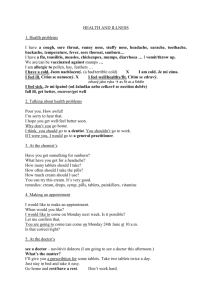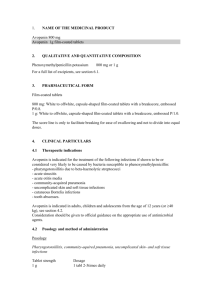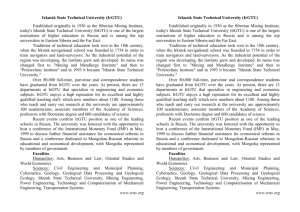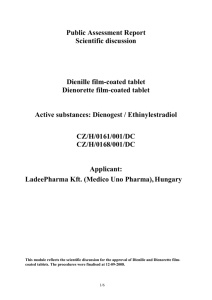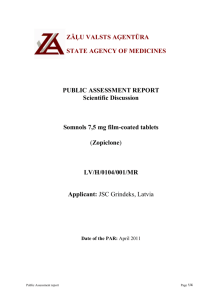Basic prescription information doc
advertisement
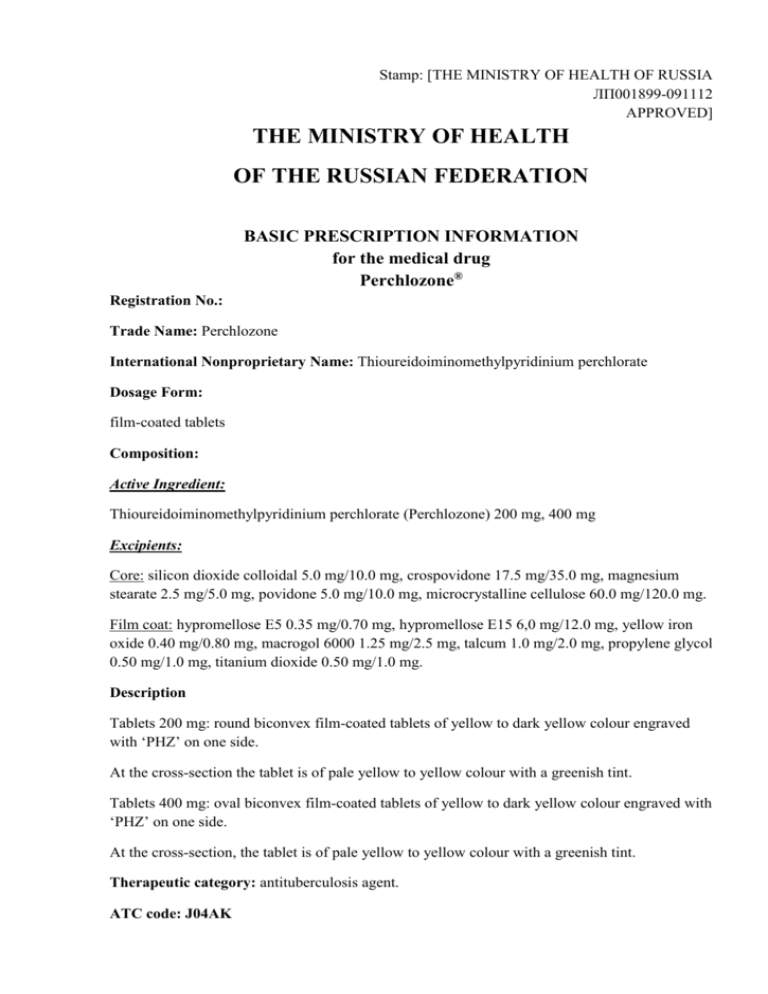
Stamp: [THE MINISTRY OF HEALTH OF RUSSIA ЛП001899-091112 APPROVED] THE MINISTRY OF HEALTH OF THE RUSSIAN FEDERATION BASIC PRESCRIPTION INFORMATION for the medical drug Perchlozone® Registration No.: Trade Name: Perchlozone International Nonproprietary Name: Thioureidoiminomethylpyridinium perchlorate Dosage Form: film-coated tablets Composition: Active Ingredient: Thioureidoiminomethylpyridinium perchlorate (Perchlozone) 200 mg, 400 mg Excipients: Core: silicon dioxide colloidal 5.0 mg/10.0 mg, crospovidone 17.5 mg/35.0 mg, magnesium stearate 2.5 mg/5.0 mg, povidone 5.0 mg/10.0 mg, microcrystalline cellulose 60.0 mg/120.0 mg. Film coat: hypromellose E5 0.35 mg/0.70 mg, hypromellose E15 6,0 mg/12.0 mg, yellow iron oxide 0.40 mg/0.80 mg, macrogol 6000 1.25 mg/2.5 mg, talcum 1.0 mg/2.0 mg, propylene glycol 0.50 mg/1.0 mg, titanium dioxide 0.50 mg/1.0 mg. Description Tablets 200 mg: round biconvex film-coated tablets of yellow to dark yellow colour engraved with ‘PHZ’ on one side. At the cross-section the tablet is of pale yellow to yellow colour with a greenish tint. Tablets 400 mg: oval biconvex film-coated tablets of yellow to dark yellow colour engraved with ‘PHZ’ on one side. At the cross-section, the tablet is of pale yellow to yellow colour with a greenish tint. Therapeutic category: antituberculosis agent. ATC code: J04AK Pharmacological Properties Pharmacodynamics An antituberculosis agent. The mechanism of action hasn’t been established. The drug is active against Mycobacterium tuberculosis and Mycobacterium bovis. Exerts evident inhibiting action on the viability of the Mycobacteria tuberculosis including those which are resistant to other antituberculosis drugs. Perchlozone is a low-toxic drug which doesn’t induce significant structural or functional disturbances in the vital organs and systems, neither does it induce irritant effect on the mucous membranes of the gastrointestinal tract. The mechanism of action hasn’t been established to the full extent, the study is ongoing. Pharmacokinetics Once orally administered Perchlozone is quickly absorbed in the gastrointestinal tract. The time to peak concentration in the blood (TCmax) is 1.5-3 hours. After oral administration as a single dose of 400 mg, 800 mg, 1200 mg or 1600 mg the peak concentration in the blood (Сmax) comes to 2.61±0.34 µg/ml, 5.07±0.69 µg/ml, 5.42±0.65 µg/ml, and 8.17±1.91 µg/ml respectively. The half-life is 12-27 hours. The time to steady state concentration (Css) of the active ingredient in the blood with long-term administration comes to 14 days. With the drug being administered as a course (once a day), the active ingredient concentration in the blood when measured 15 minutes before a regular dose intake is 23.4 µg per 1 ml of the blood plasma. The metabolic pathways of the active ingredient haven’t been established, the study is ongoing. Indications Pulmonary tuberculosis including the cases with multidrug resistance of the Mycobacteria tuberculosis (as a part of combination therapy). Contraindications Hypersensitivity to the active ingredient or any other components of the drug, impaired liver and/or kidney function (application of the drug in such patients hasn’t been studied), pregnancy, breast feeding, children (under 18 years old). Warnings Elderly patients. Pregnancy and Breastfeeding The drug is contra-indicated to be used in pregnant or breastfeeding patients. Dosage and Administration The drug is to be taken orally, once a day after meal. The drug is administered to adults at 9.512.5 mg/kg/day: 400-600 mg/day with the body weight less than 50 kg; 800-1000 mg/day with the body weight of 50-80 kg; not more than 1200 mg/day with the body weight more that 80 kg. The duration of the therapy is up to 3 months. Adverse Effects Nervous system: vertigo, headache, weakness, sleepiness, loss of consciousness, neuropsychic reactions (aggression, depression). Cardiovascular system: tachycardia, palpitation, blood pressure decrease. Digestive system: pain in the epigastrium, liver transaminase activity increase, nausea, vomiting. Allergic reactions: itch, rash, dermahemia, toxic allergic reactions, angioneurotic edema. Other: bronchospasm, fever, eosinophilia, hot flash. Overdosage There are no available data on acute overdosage associated with Perchlozone intake in human. Treatment: specific antidote is unknown. In case of an overdosage, general supportive therapy with control of the basic physiological parameters is needed. It is recommended to perform gastric lavage and to administer activated carbon. Drug Interactions Interaction with other drugs hasn’t been studied to the full extent. With simultaneous administration of Perchlozone with other antituberculosis drugs (isoniazid, amikacin, rifabutin, rifampicin) increase in the activity against Mycobacteria tuberculosis is observed. At that, it is important to consider possible potentiation of the adverse effects. Special Instructions In case of occurrence of allergic reactions it is recommended to withdraw the drug. Do not use metamizole sodium (analgin) for the purpose of relieving fever. In case of occurrence of other abovementioned adverse reactions, it is recommended to consider the possibility of reducing the dose to 400 mg/day or withdrawal of the drug. Effects on ability to drive and use machines No specialized study of the Perchlozone effects on the ability to drive and use machines was performed. Such adverse events as vertigo, weakness, sleepiness (see the section Adverse Effects) can impair reactivity and the ability to concentrate attention. During the Perchlozone therapy, it is recommended to avoid driving and doing potentially dangerous activities requiring high level of attention and high rate of psychomotor reactions. Presentation: 200 mg, 400 mg film-coated tablets. Primary package of the drug product 10 tablets are packed in each blister made of PVC film and printed laminated aluminium foil. 50 or 100 tablets are placed in each polymer jar with a tamper-evident pull-off cap. The free space is filled with medical absorbent cotton. Stickers made of tag/writing paper or of polymeric materials are attached to the jars. Secondary package of the drug product 5 or 10 blisters along with a package insert are placed in a pack made of carton for consumer containers of ‘chrome’ or ‘chrome-ersatz’ categories, or other of similar quality. The packs are placed into a multipack, a box made of corrugated cardboard. Shelf-life 2 years. Do not use after the expiry date which is stated on the package. Storage Store in a dry place protected from light, do not store above 25ºС. Keep away from children. Dispensing Terms Rx. Manufacturer JSC Pharmasyntez, Russia. Registered address: office 3, building 23, Krasnogvardeyskaya street, Irkutsk, 664007, Russia. Facility address: 1 floor, building 184, R. Luxemburg street, Irkutsk, 664040, Russia. Consumer complaints to be addressed to: JSC Pharmasyntez, building 184, R. Luxemburg street, Irkutsk, 664040, Russia, tel.: (3952) 55-03-55, fax: (3952) 55-03-25. General director JSC Pharmasyntez Stamp: [JOINT STOCK COMPANY PSRN 1023801426538 * IRKUTSK* PHARMASYNTEZ FOR REGISTRATION DOCUMENTS] O.V. Turchaninova /signed/ 2012 Stamp: [THE MINISTRY OF HEALTH OF RUSSIA ЛП001899-091112 APPROVED] Stamp: [bound and numbered /5/ page(s) General director Pharmasyntez JSC O.V.Turchaninova /signed/ /30.10.2012/] Stamp: [JOINT STOCK COMPANY PSRN 1023801426538 * IRKUTSK* PHARMASYNTEZ FOR REGISTRATION DOCUMENTS]



